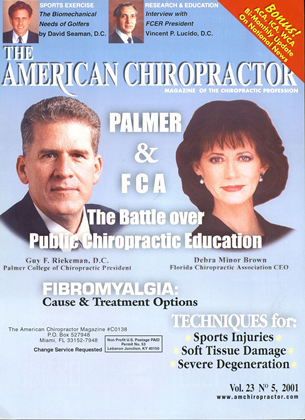How often have you contemplated, in great detail, what you are in your practice for? I mean, what exactly are you there for? What are the prime driving forces that get you to show up each day? What is it that you wish to accomplish? How do you define if you had a successful day. month, year? What out- comes do you hope tor from each patient? How do you know if you are getting them? There are always lots of questions. What are the answers? More specifically, what are your answers? If you constantly focus on and improve the clarity of the answers to these questions, you are. then, constantly improving your life and practice. Why do you practice? If by some stroke of good fortune, you suddenly had several million dollars in the bank, would you go back to your practice? If you would, what would you change? I have gotten many different (some amusing) answers to this question when I pose it to chiropractors I consult with. I asked one fellow, who couldn't understand why his practice wasn't growing, it" he would show up at the office Monday if 1 deposited five million dollars into his bank account. He responded. "Yeah, to tell the patients I won't be back for a long time." That spoke volumes as to why his practice wasn't growing. Other chiropractors respond that they would use the money to grow their practices. Good answer. Your practice plays a role in your life, personally, in your family's life. and. hopefully, an important role in the community. As a result, there may be many answers to the question of why you practice. Personally, you find it fulfilling. It supports your family. It serves the needs of people in your community. How clearly do you experience any of this? Perhaps your experience is you can barely hold on financially. You spend too much time at the office and not enough with your family. Or. people in your community complain that, after seeing you. they are not getting "better". You could get another job. Maybe make more money...be more appreciated. This brings us back to, "What are you there for?" There must be a more primary issue. Was there a time when you fell in love with the principles of chiropractic? When was the last time you really contemplated those principles? Many times, the real world of practice steals away the romantic vision of a career in chiropractic that many doctors held as students. This has happened to so many people. 1 have proven time and again, to myself and to others, though, that this romantic vision can and should become a reality. One of the most common reasons for burnout in chiropractic is what I call the silent dread. Let me explain. Most chiropractors tell me that the central focus in their practices is detec- tion and correction of vertebral sublux- i ation (VS). They understand the philosophy related to subluxation. They have studied the hard-core science of VS. They market their practice based on it. They leach their health care classes and do reports of findings centered around vertebral subluxation. Then, when it comes time to examine the patient, most chiropractors are still doing ortho/ncuro exams, which don't find subluxations. This is why patient retention is low, and this is also why not many kids are patients in most practices. How many seven-year-olds • have positive Kemp's or cervical compression tests? Yet most are subluxat-ed. The next step. then, is that you adjust a patient and tell them you will see them twice next week. Why twice? Why not once? Why not three times? Based on what? Blank out. This is the silent dread of which I spoke earlier. Imagine practicing year after year and having to blank out the contradiction I describe above. No wonder so many chiropractors burn out. When they ask themselves the question. "Why am I really in practice?" and the answer is. "To remove subluxations from people in my community so that they can maximize their health expression, and to satisfy my sense of purpose and support my family," they realize that they may be selling a product they are not sure they are delivering. This becomes psychologically devastating. One can only blank out so long before one crashes. I have found that the clearer a chiropractor understands his/her purpose in practice, though, the greater the level of success and fulfillment. By focusing on and answering the questions I have posed in this article, you can really set a start on understanding the dri- ving forces that take you in the direction of a purpose. If you don't like the answers you get to some of the questions, then you may change them, which, in turn, will change your life. It is in your hands now. What will you do? Don't blank out! Patrick Gentempo. Jr.. D.C., Co-Founder and CEO of the Chiropractic Leadership Alliance in Maywoocl. NJ, is a 1983 graduate of Life College. An internationally renowned chiropractor, lecturer, and consultant, he has helped thousands of chiropractors achieve success and balance in their lives. Dr. Gentempo is also co-creator of the practice and life-changing Total Solution program. For information about CLA seminars, products, and services, call 800-285-2001, or visit \\\\w.suhlu.\ation.com .Q
 View Full Issue
View Full Issue






